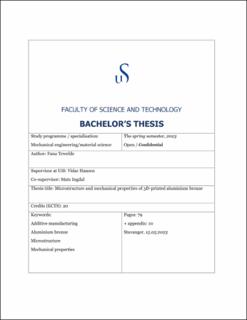| dc.contributor.advisor | Hansen, Vidar | |
| dc.contributor.author | Tewelde, Fana | |
| dc.date.accessioned | 2023-07-01T15:51:48Z | |
| dc.date.available | 2023-07-01T15:51:48Z | |
| dc.date.issued | 2023 | |
| dc.identifier | no.uis:inspera:135971362:64398244 | |
| dc.identifier.uri | https://hdl.handle.net/11250/3075078 | |
| dc.description.abstract | Additive manufacturing has been growing rapidly in several industries since the late 1980s. In this thesis,
mechanical properties and microstructure of a 3D-printed aluminum bronze have been investigated.
Mechanical properties were identified through tensile tests, Charpy V tests and Vickers hardness tests.
Microstructural investigation was done with optical microscope and SEM, including EBSD and EDS. The
results obtained from the tensile test and Charpy V test should be considered as a preliminary indication
rather than absolute representative for the aluminum bronze. This is due to certain errors that occurred
during testing. Additional testing should have been performed to obtain more accurate and representative
results. However, it was difficult to perform additional testing, due to the limited available material.
The three Charpy V tests that were carried out showed that the aluminum bronze mean absorbed energy
were 33,7J, and the standard deviation was 11. For the three tensile test that was performed, it was found
that the yield strength at 0,2% offset was 204,9MPa with standard deviation of 1,69. The mean tensile
strength was found to be 533,0MPa with standard deviation of 3. The mean elongation at break was found
to be 57,7% with standard deviation of 5,29, but the property was found to be approximately 45% when
measuring manually. The modulus of elasticity varied quite a lot between test specimens, due to
measuring errors. With SEM investigation performed on the fractured surfaces, ductile microstructural
properties were observed. Almost a total of 1000 hardness indenters were done. The results showed that
the material was hardest at the bottom near the base that the metal was 3D-printed onto. The mean
hardness value measured was 135 with standard deviation of 10,4.
Dendritic structures were observed in the optical microscope. They were investigated further to determine
the local solidification rate in the top and bottom part of the material. It was found that the cooling rate
was 5,5% faster in the bottom than at the top.
With SEM and EDS analysis, it was possible to observe the iron-rich 𝜅 precipitates that were observed
over larger regions, especially at the grain boundary areas. Additional time would be needed in order to
get good results in the EBSD analysis, as certain areas were not diffracting. However, the FCC crystal
structure were observed. | |
| dc.description.abstract | Additive manufacturing has been growing rapidly in several industries since the late 1980s. In this thesis,
mechanical properties and microstructure of a 3D-printed aluminum bronze have been investigated.
Mechanical properties were identified through tensile tests, Charpy V tests and Vickers hardness tests.
Microstructural investigation was done with optical microscope and SEM, including EBSD and EDS. The
results obtained from the tensile test and Charpy V test should be considered as a preliminary indication
rather than absolute representative for the aluminum bronze. This is due to certain errors that occurred
during testing. Additional testing should have been performed to obtain more accurate and representative
results. However, it was difficult to perform additional testing, due to the limited available material.
The three Charpy V tests that were carried out showed that the aluminum bronze mean absorbed energy
were 33,7J, and the standard deviation was 11. For the three tensile test that was performed, it was found
that the yield strength at 0,2% offset was 204,9MPa with standard deviation of 1,69. The mean tensile
strength was found to be 533,0MPa with standard deviation of 3. The mean elongation at break was found
to be 57,7% with standard deviation of 5,29, but the property was found to be approximately 45% when
measuring manually. The modulus of elasticity varied quite a lot between test specimens, due to
measuring errors. With SEM investigation performed on the fractured surfaces, ductile microstructural
properties were observed. Almost a total of 1000 hardness indenters were done. The results showed that
the material was hardest at the bottom near the base that the metal was 3D-printed onto. The mean
hardness value measured was 135 with standard deviation of 10,4.
Dendritic structures were observed in the optical microscope. They were investigated further to determine
the local solidification rate in the top and bottom part of the material. It was found that the cooling rate
was 5,5% faster in the bottom than at the top.
With SEM and EDS analysis, it was possible to observe the iron-rich 𝜅 precipitates that were observed
over larger regions, especially at the grain boundary areas. Additional time would be needed in order to
get good results in the EBSD analysis, as certain areas were not diffracting. However, the FCC crystal
structure were observed. | |
| dc.language | eng | |
| dc.publisher | uis | |
| dc.title | Mikrostruktur og mekaniske egenskaper til 3D-printed aluminium bronse | |
| dc.type | Bachelor thesis | |
